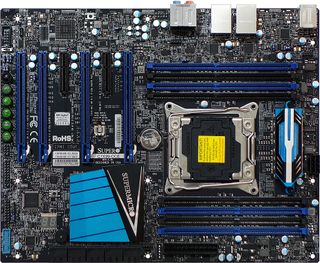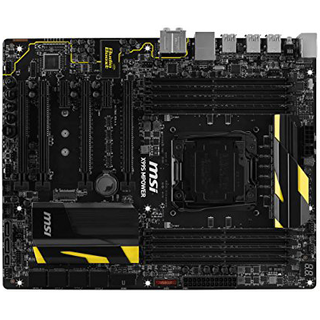Early Verdict
A premium-priced board with few basic features, Supermicro’s C7X99-OCE is best suited to Supermicro’s rising fan base.
Pros
- +
Dual Intel Gigabit Ethernet and Supermicro’s reputation for stability and longevity.
Cons
- -
Few added features, reduced implementation of chipset-integrated data ports, and minor overclocking difficulties.
Why you can trust Tom's Hardware
Reliable Overclocking?
Famed for its reliability in the server market, Supermicro was once known to enthusiasts only for its cases. The company finally decided to dip a toe into the overclocking market with the C7Z87-OCE motherboard. But it wasn’t until Intel's Z97 update that Tom’s Hardware finally felt the teething pains of a company that was most experienced building business-oriented hardware. Today’s C7X99-OCE brings over two years of overclocking-related firmware advancements to users who want the added cores or PCIe 3.0 lanes of Haswell-E via LGA 2011-v3.

The C7X99-OCE is even rated for four-way SLI, though the dual-slot brackets and coolers of most compatible cards makes it unlikely that enthusiasts will try squeezing a third card into that single space before the fourth slot. You’d also lose front-panel USB 3.0, since the solitary header is located along the bottom edge. Heck, you might even lose the use of that header with a third card, depending on whether your double-space cooler is more than 8.4” long. Before we dig deeper into the connectors, here’s how it compares to the rest of our ~$300 boards:
| X99 Mainstream Motherboard Features | ||||
|---|---|---|---|---|
| Row 0 - Cell 0 | Supermicro C7X99-OCE | MSI X99S MPower | ASRock X99 Extreme6/ac | Asus X99 Pro |
| PCB Revision | 1.01 | 4.0 | 1.07 | 1.01 |
| Chipset | Intel X99 | Intel X99 | Intel X99 | Intel X99 |
| Voltage Regulator | Eight Phases | 12 Phases | 12 Phases | Eight Phases |
| 100MHz BCLK | 99.98 (-0.02%) | 99.98 (-0.02%) | 99.94 (-0.06%) | 99.94 (-0.06%) |
| I/O Panel Connectors | ||||
| P/S 2 | 1 | 1 | 1 | 1 |
| USB 3.0 | 6 | 8 | 6 | 6 |
| USB 2.0 | None | 2 | 2 | 4 |
| Network | 2 | 1 | 2 | 1 |
| eSATA | None | None | 1 | None |
| CLR_CMOS Button | None | 1 | 1 | 1 |
| Digital Audio Out | Optical | Optical | Optical | Optical |
| Digital Audio In | None | None | None | None |
| Analog Audio | 5 | 5 | 5 | 5 |
| Other Devices | None | None | 2x Wi-Fi Antenna | 2x Wi-Fi Antenna |
| Internal Interfaces | ||||
| PCIe 3.0 x16 (Core i7-5960X, -5930K) | 4 (x16/x8/x8/x8) SLI x4, CrossFire x4 | 4 (x16/x16/x0/x8*, x8/x16/x8/x8*) SLI x4, CrossFire x4 *Forces M.2 to PCIe 2.0 x2 | 3 (x16/x16/x8) SLI x3, CrossFire x3 M.2 disables x8 slot | 3 (x16/x16/x8) SLI x3, CrossFire x3 M.2 disables x8 slot |
| PCIe 3.0 x16 (Core i7-5820K) | 4 (x16/x0/x8/x0) SLI x2, CrossFire x2 | 4 (x16/x8/x0/x4*, x8/x8/x8/x4*) SLI x3, CrossFire x4 *Forces M.2 to PCIe 2.0 x2 | 3 (x16/x8/x4) SLI x2, CrossFire x3 M.2 disables x4 slot | 3 (x16/x8/x4) SLI x2, CrossFire x3 M.2 disables x4 slot |
| PCIe 2.0 x16 | None | None | None | 1 (x4, shares 1x PCIe x1, 1x USB 3.0 controller [2-ports]) |
| PCIe 2.0 x1 | 2 (x4 slot length) | 2 (open-ended) | 2 (+1x mini-PCIe, Filled) | 2 (1x w/x16, 1x w/Wi-Fi) |
| USB 3.0 | 1 (2-ports) | 2 (4-ports) | 2 (4-ports) | 2 (4-ports) |
| USB 2.0 | None | 2 (4-ports) | 2 (4-ports) | 2 (4-ports) |
| SATA 6.0 Gb/s | 10 | 10 (Shares M.2/SATA-E) | 10 (Shares M.2/SATA-E) | 10 (2x Shared w/SATA-E) |
| SATA Express | None | 1 (Uses 2x SATA) | None | 1 (Uses 2x SATA) |
| M.2 Interfaces (Transfer Modes) | None | 1 (PCIe 3.0 x4, PCIe 2.0 x2, SATA 6Gb/s x2) | 1 (PCIe 3.0 x4, SATA 6Gb/s x1) | 1 (PCIe 3.0 x4-only) |
| 4-Pin Fan | 5 | 5 | 2 | 6 (5x PWM/DC dual-mode) |
| 3-Pin Fan | None | None | 4 | None |
| FP-Audio | 1 | 1 | 1 | 1 |
| S/PDIF I/O | None | None | None | Output Only |
| Internal Buttons | Power, OC1/2/3/DRAM/Home, CLR CMOS, BIOS Restore | Power, Reset, OC-Genie, Clock +/- | Power, Reset | Power, Reset, Mem_OK |
| Internal Switch | BIOS Recovery Mode | Slow Mode, BIOS Selector | Dual BIOS Selector | XMP, EPU (low-energy), TPU (auto-overclocking) |
| Diagnostics Panel | Numeric | Numeric | Numeric | Numeric |
| Other Devices | Serial COM, OC Front Panel | None | Serial COM, TB_Header, HDD-Saver, USB Type-A | Serial COM, TB_Header, EXT_FAN |
| Mass Storage Controllers | ||||
| Chipset SATA | 10x SATA 6Gb/s | 10x SATA 6Gb/s (Includes M.2, SATA-E) | 10x SATA 6Gb/s (Includes M.2, eSATA) | 10x SATA 6Gb/s (Includes M.2, SATA-E) |
| Chipset RAID Modes | 0, 1, 5, 10 (Ports 1-6) | 0, 1, 5, 10 (Ports 1-6) | 0, 1, 5, 10 (Ports 1-6) | 0, 1, 5, 10 (Ports 1-6) |
| Add-In SATA | None | None | None | None |
| USB 3.0 | None | VL805 PCIe ASM1042 PCIe | ASM1042e PCIe ASM1072 Hub | ASM1042e PCIe ASM1072 Hub |
| Networking | ||||
| Primary LAN | Intel i210 PCIe | Intel i210 PCIe | WGI218V PHY | WGI218V PHY |
| Secondary LAN | Intel i210 PCIe | None | AR8171 PCIe | None |
| Wi-Fi | None | None | BCM4352 PCIe 802.11ac dual-band / BT 4.0 | BCM4352 PCIe 802.11ac dual-band / BT 4.0 |
| Bluetooth | None | None | BT 4.0 / Wi-Fi Combo | BT 4.0 / Wi-Fi Combo |
| Audio | ||||
| HD Audio Codec | ALC1150 | ALC1150 | ALC1150 | ALC1150 |
| DDL/DTS Connect | None | None | DTS Connect | DTS Connect |
| Warranty | Three Years | Three Years | Three Years | Three Years |

Huawei's next-gen CPU could rival Apple's current best — Kirin CPU with Taishan V130 cores rumored to match Apple M3 performance

Intel needs $2 Billion for New Ireland fab — courting three venture capital firms for continued expansion

AMD's server CPUs arrive on mainstream PC motherboards — EPYC 4004 CPUs with 3D V-Cache for AM5 platform already on sale at eBay
-
InvalidError Reply
Tons of consumer electronics in North America only have a one-year manufacturer warranty regardless of price range.15434696 said:Is it only me or does 3 year warranty on $300 components seem a little low?
Personally, I think three years should be the minimum legal warranty: reduce the amount of e-waste generated by device manufacturers engineering their products to barely outlive the warranty. Making retailers accountable for part of the warranty repair costs would also give them incentive to avoid stocking dodgy products.
(Except on batteries which people can ruin within months by abusing the heck out of them, one more reason to make batteries user-replaceable again.) -
wolverine96 It seems like a good motherboard for most users' needs. Supermicro followed the old saying, Keep It Simple, Stupid!I kind of like the complete absence of USB 2.0. Who really needs USB 2.0, when USB 3.0 is backward-compatible? The only slight problem I can think of is the front USB 2.0 ports on your case will be useless, but there are other case options out there.Reply -
firefoxx04 Does Win8 / Win10 have native usb 3.0 support? I imagine they do. I know I have a hard time installing windows 7 when my USB key / keyboard / mouse are plugged into a usb 3.0 port.Reply
I like seeing that USB 3 is becoming prevalent but it worries me a bit for 100% backwards comparability. I guess installing a driver during install is not too trivial but it is annoying. -
Crashman Reply
Blame the motherboard manufacturer, probably, as most of those old systems relied on third-party controllers not supported by native drivers. Remember that USB 3.0 is a 2-in-1 interface, the USB 2.0 connection is still there (chipset-based ports should be supported in USB 2.0 mode prior to updating the drivers).15438455 said:Does Win8 / Win10 have native usb 3.0 support? I imagine they do. I know I have a hard time installing windows 7 when my USB key / keyboard / mouse are plugged into a usb 3.0 port.
I like seeing that USB 3 is becoming prevalent but it worries me a bit for 100% backwards comparability. I guess installing a driver during install is not too trivial but it is annoying.
-
bit_user Reply
I have one of their older Socket 2011 workstation boards.15434487 said:Can Supermicro deliver its legendary server-component reliability
I've been happy with it, so far (no overclocking or multi-GPU, though). My only complaint is a significant hissing on the line-out port, forcing me to use a separate sound card. But when I viewed the Newegg reviews a year later, it sounded like they had some serious quality problems starting shortly after I bought mine.
So, maybe they've already lost that "legendary reliability"? It wasn't a cheap board, either.
I just bought an ASRock mini-ITX server board, though it was the only option with all the features I wanted. We'll see how that works out...
-
Bolts Romano why do motherboard maker still provide ps2 connector on the motherboard?Reply
Is there people still use ps 2 keyboard today?
Is there people who can afford to buy 300 dollars motherboard and still use 1998 keyboard and mouse?
-
Crashman Reply
2 markets. Some people love their old mouse, others love their old mechanical keyboards. That's 2 markets, 1 port, roll the dice and hope the crossover doesn't hurt your marketing :)15448545 said:why do motherboard maker still provide ps2 connector on the motherboard?
Is there people still use ps 2 keyboard today?
Is there people who can afford to buy 300 dollars motherboard and still use 1998 keyboard and mouse?
-
bit_user Replywhy do motherboard maker still provide ps2 connector on the motherboard?
heard of BadUSB? Some people are disabling USB HID on their PCs. Granted, that's pretty uncommon.
Is there people still use ps 2 keyboard today?
Is there people who can afford to buy 300 dollars motherboard and still use 1998 keyboard and mouse?
I still use a PS/2 keyboard I paid $300 for, years ago. I do have a USB adapter for it, but I think it increases the number of missed key presses/releases.



